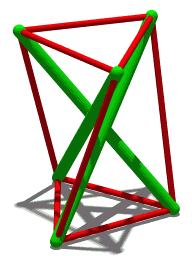Biconical Antenna Build
Antenna properties
Biconical dipole antennas (wikipedia link) are just two cones with the pointy ends at each other. They are supposed to have fairly good impedance bandwidth and good *pattern* bandwidth over that same wide range. In retrospect I think I should've just cut the frustrum shape out of aluminum flashing sheet for all the tedious soldering work assembling this out of copper coated steel welding rods took. All hooked together the conductive structure stands about 2m tall. Some day I might add curved end caps to the cones but it'd complicate the support structure.
The frequency range should be like a very fat dipole on the low end and limited by construction errors on the high end. I did make the top of the cones out of tin sheet so they're pretty smooth. The join is also a very small gap distance. So the 15 db return loss defined low end might be ~300 MHz and the high end somewhere in the 2-3 GHz range. I'll measure with a VNA sometime.
Support structure

I thought about how I wanted to do the mechanical support in depth and made plans for how to do it for weeks. Then when it came time to build I ignored the square box plans and did something entirely different. So I could only use 3 rods I decided to make a tensegrity prism. As a single person the challenge of holding it all together and upright while running the cord (and fishing line) was daunting. I let it fall off center sloppily while I went in a circle around the triangle progressively tightening all the tension lines between the compression spars. The zip ties holding the spars to the copper ring at the end of each cone helped a lot.
Anyway, here's a progressive series of photos from tin frustrums rolled into cones to a working antenna standing outside.
I calculated the two arc lengths of the frustrum needed and modeled it in SketchUp at 1:1 scale. I used it as cutting template for zinc sheet and then rolled it into shape and soldered.
I used copper coated low carbon content steel rods as wire elements because they are cheap. They're stiff and fairly conductive.
I used a normal panel mount F connector as the feed point. In retrospect I should've just done this with RG6 coax cut bare and connectorized because I needed to add an extension anyway to make it easier to screw.
The soldering of the wires onto the cone tips was extremely awkward and took a lot of burnt fingertips and little jigs made out of random heavy crap I had lying around. It tooks a long time. In the future I think it'd be easier to just cut large sheet frustrums and fold them instead of using wire rods.
I don't really have photos of the raising of the tensegrity structure because it was just me and once I started I needed to finish it otherwise it'd break at the feed point. But this is it assembled and being tested.
I made ever larger holes and slots in the PVC support tube for the cones in order to be able to properly solder it. I never really succeeded at this which lead to the next step.
I eventually decided to just glob on an excess of solder not caring about bridging then I went in with a rotary tool and ground it down (relatively) flat so there were no bridges or electrical shorts. This whipped the coaxial plastic up a bit but it shouldn't effect performance too bad.
[comment on this post] Append "/@say/your message here" to the URL in the location bar and hit enter.
